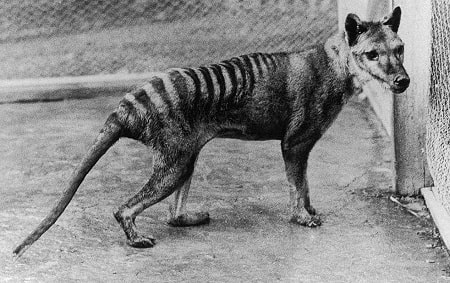Thylacine is a carnivorous large mammal. It has a long tail, short legs, a huge head. Their ears were also short, erect and their fur was dense and short.
Origin & History
Thylacine originated more than 4,000,000 years ago. The Thylacine was found and lived throughout the Australian continent, from New Guinea to Tasmania.
Tasmania’s midland region, from north to east coast was popular with the breed. However, it wasn’t well-known in the south.
How did the Thylacine become extinct?
Thylacine was extinct due to Dingo’s competition. The Australians’ hunting pressure also led to a decline in their numbers.
Thylacine was extinct on the Australian continent no less than 2000 year ago. The breed was still present in Tasmania until the end of the 20th century.

National Museum of Australia
The dogs began to disappear after they arrived in Tasmania. It is believed, along with this, that the Tasmanian natives also persecuted them. It was mainly because people regarded these creatures as pests.
Benjamin was the last Thylacine to die on 7 September 1936. Just two months later, Tasmanian authorities declared the breed a protected specie. The Beaumaris Zoo where Benjamin was housed had been careless.
The officials locked out the cage by mistake on a very cold night. It couldn’t cope with the freezing temperatures and eventually died.
Temperament, Behavior, & Personality
Thylacines have a temperament very similar to other animals in Australia and Tasmania. Although they were not very aggressive, they wouldn’t hesitate to defend themselves in the event of fear. The were quiet and reserved creatures that rarely visited human homes.
Like wolves and hyenas, the Thylacines prefer to be in groups. They also fought to be the head of their pack.
Is Thylacine good with children?
Thylacines are not domesticated animals. They were never raised by humans. They didn’t know how to interact with humans. It’s never been a good thing to assume that these marsupials are suitable for kids.
Amazing Facts
- Due to its lower-back stripes, the Thylacine is also called Tasmanian Tiger and Tasmanian Wolf.
- The kangaroos would sometimes hop up on their legs.
- Ancient rock art from Northern Australia depicts the existence of Thylacine.
- Two Thylacines are featured on each side of the Tasmanian Coat-of-Arms.
- Many people mistakenly believe the Thylacines to be a dog species. The marsupials that have characteristics like wolves or tigers are called marsupials.
- The male Thylacines are the only marsupials in Australia to have a scrotal pouch. It was a protective pouch for the external organs.
- The mouth could be opened up to 120°.

Colors
Thylacine is found in these colors:
- Grey
- Yellowish-Brown
- Sandy
You can also Size
Thylacines used to be a tall animal, standing between 39 and 51 inches (100-130 cm), with a weight of 33 to 66 pounds (15-30 kg).
Puppies
A mother Thylacine usually gives birth to between 1-4 pups at one time.
Related Breeds
- Canidae
- Numbat